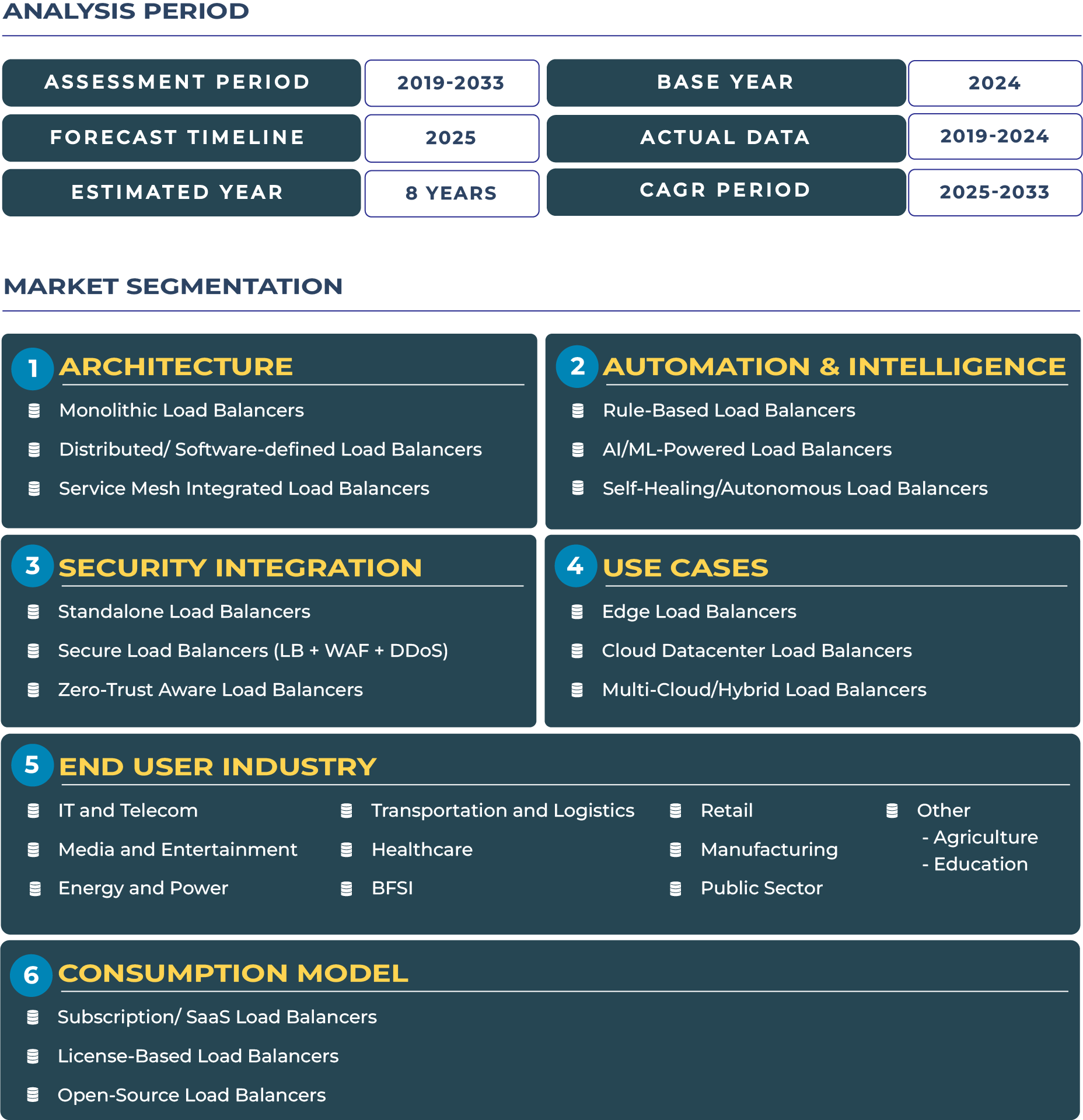Report Format:
![]()
![]() |
Pages: 110+
|
Pages: 110+
Self-Reliant Domestic Cloud Giants: China Cloud Load Balancers Market Outlook
China has built a distinctive cloud ecosystem anchored by its state-supported hyperscalers, creating a self-reliant framework that prioritizes digital sovereignty and domestic technological independence. Within this environment, the cloud load balancers market plays a central role in ensuring the scalability and reliability of mission-critical applications across sectors such as e-commerce, gaming, streaming, and fintech. The market is estimated at USD 90.9 million in 2025 and is projected to reach USD 308.9 million by 2033, expanding at a CAGR of 16.5% from 2025–2033. This acceleration is backed by policy-driven adoption, strong demand for domestic cloud services, and integration of advanced traffic management systems by leading players such as Alibaba Cloud and Tencent Cloud. With regulatory measures shaping the digital landscape, service mesh integrated load balancers are being increasingly deployed to manage multi-tenant architectures, optimize data residency compliance, and deliver superior user experiences for China’s massive online population. This trend underscores the pivotal role of sovereign cloud infrastructure in advancing the nation’s broader digital economy.
Explosive OTT Demand and Hyperscaler Strength as Core Drivers
The China cloud load balancers industry is propelled by unique market conditions that amplify its growth trajectory. China hosts one of the world’s largest internet and OTT user bases, where traffic peaks across platforms like Tencent Video, Bilibili, and iQIYI demand advanced balancing solutions to ensure uninterrupted streaming and gaming experiences. Furthermore, domestic hyperscalers such as Alibaba Cloud and Huawei Cloud have developed robust infrastructures tailored to the country’s sovereignty policies, positioning them as leaders in distributed and software-defined load balancing frameworks. The large-scale gaming market, which includes global players like Tencent Games, further reinforces the need for resilient load balancing strategies to manage millions of concurrent users. Together, these factors consolidate China’s dominance in hyperscaler-driven adoption and reinforce its trajectory as one of the most dynamic growth markets for cloud load balancing.
Regulatory Barriers and Localized Competition as Market Restraints
While growth prospects are strong, the cloud load balancers sector in China faces structural restraints shaped by regulatory frameworks and market dynamics. Stringent data residency and cybersecurity regulations enforced by the Ministry of Industry and Information Technology (MIIT) require all cloud data, including load balancing traffic, to remain within domestic borders. This has limited the role of international hyperscalers and restricted foreign technology integration. Additionally, intense local competition among domestic players has created price pressures, often resulting in commoditization of basic load balancing services. Smaller enterprises also face barriers in accessing advanced solutions due to high compliance costs. These challenges highlight the need for differentiated offerings such as compliance-driven load balancers and vertical-specific solutions tailored to China’s unique digital environment.
AI-Powered Traffic Management and CDN Convergence Shaping Market Trends
The cloud load balancers landscape in China is rapidly evolving with transformative trends reshaping the industry. One key development is the convergence of Content Delivery Networks (CDNs) and load balancing for video streaming, online education, and e-commerce platforms. Providers like Tencent Cloud are combining load balancing with edge caching capabilities to deliver seamless experiences for millions of daily active users. AI-driven traffic management has also emerged as a critical trend, enabling predictive routing and adaptive load balancing to handle unpredictable demand surges. Regional innovation hubs such as Shenzhen and Hangzhou are leading this adoption, driven by high-density tech clusters and a surge in SaaS demand. Collectively, these trends underscore the shift towards intelligent, automated, and hybrid load balancing solutions.
Expanding Opportunities with Gaming, OTT, and Vertical-Specific Load Balancers
The China cloud load balancers market presents compelling opportunities for providers to develop localized solutions aligned with vertical industries. With gaming and OTT services accounting for massive portions of internet traffic, the need for vertical-specific load balancers optimized for low latency and high concurrency is accelerating. Partnerships with domestic CDNs and telecom operators are unlocking new models for edge-based load balancing, particularly in high-traffic provinces such as Guangdong and Jiangsu. Additionally, the integration of freemium and developer-focused solutions tailored to China’s startup ecosystem can unlock wider adoption in small and mid-sized enterprises. These opportunities reflect how the industry is evolving beyond commoditized offerings towards specialized, value-driven solutions.
Localized Strategies and Strategic Partnerships Defining Competitive Landscape
The China cloud load balancers ecosystem is shaped by a strong roster of domestic players including Alibaba Cloud, Tencent Cloud, Huawei Cloud, and Baidu AI Cloud, each leveraging state support and market dominance to expand their load balancing portfolios. International providers face limited access but continue to explore niche collaborations through joint ventures and compliance-driven partnerships. In 2024, Alibaba Cloud launched enhanced distributed load balancing solutions tailored for AI-heavy workloads, reinforcing its competitive edge in domestic and regional markets. Similarly, Tencent Cloud partnered with leading CDNs to strengthen its hybrid load balancing offerings for gaming and streaming use cases. Strategies revolve around localization, compliance-first product design, and AI-driven innovation, enabling providers to capture demand in a market where sovereignty, scale, and intelligence remain decisive success factors.







